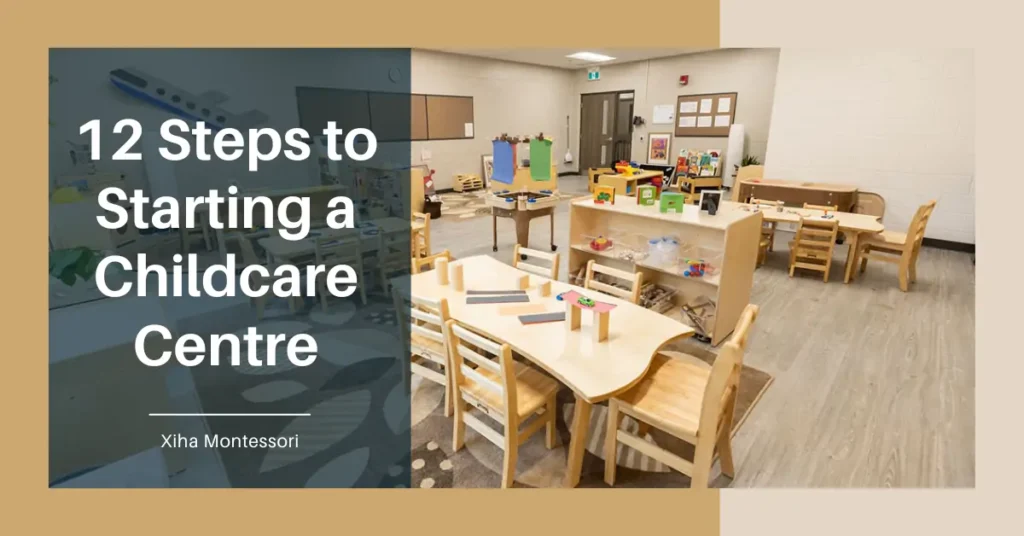Are you passionate about working with children and dream of starting your childcare centre? Help turn your vision into reality in this comprehensive guide. Before you begin, find out if childcare is right for you. This will help you consider some important things before opening a childcare centre. Visit our website to learn more about childcare centers and other childcare services.
Starting a childcare centre can be rewarding and profitable but requires careful planning and attention to detail. And creating educational programs for children of all ages.
Whether you’re an experienced childcare professional looking to expand your business or want to turn your passion for children into a career, this article will provide the information and guidance you need to successfully start and run a childcare centre. Let’s take the first step in creating an environment for children to grow and be educated.
1. Conduct Market Research
Conducting thorough market research helps you identify the needs of your target market and develop services that meet those needs.
- Identify Your Target Market:
Start by identifying the demographics of your area. This includes the age range of children, income levels of families, and employment rates. Understanding these factors helps you tailor your services to meet your community’s needs. - Analyze Competitors:
Research other childcare centres in your area. Analyze their strengths and weaknesses, their services, and their pricing. Understanding your competition allows you to differentiate your centre and offer unique services that attract families. - Conduct Surveys and Focus Groups:
Gathering direct feedback from parents can provide invaluable insights. Conduct surveys and focus groups to understand what parents seek in a childcare centre. Ask about their preferences, pain points, and expectations. Use this feedback to shape your services and policies. - Evaluate Market Trends:
Stay updated on market trends in early childhood education. This includes understanding new educational methods, technological advancements, and changes in regulatory requirements. Keeping abreast of trends ensures your centre remains competitive and compliant.
Market research helps determine the type of childcare services needed and the age groups you will cater to. It also guides your decisions regarding pricing, location, and marketing strategies.
2. Develop a Business Plan
The business plan is your roadmap to success. It should include your mission statement, market analysis, organizational structure, marketing and sales strategies, operational plan, and financial projections.
Your business plan is essential when seeking funding. It demonstrates your commitment and provides a clear strategy for achieving your goals.
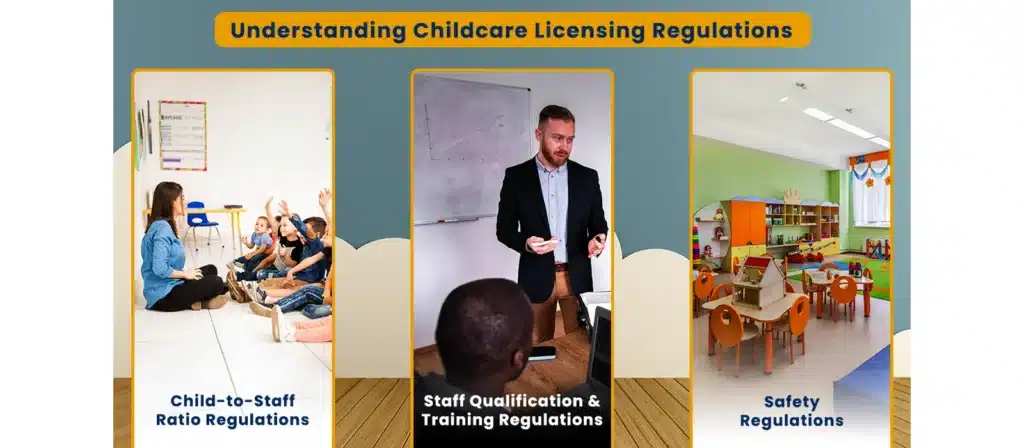
3. Understand Childcare Licensing Requirements
Every region has specific licensing requirements for childcare centres. These include health and safety inspections, staff background checks, and insurance proof. Research the regulations in your area and ensure compliance.
Licensing is not a one-time process. Ensure you stay compliant by keeping up with any changes in regulations and renewing your licenses as required. Regularly review your policies and procedures to maintain high standards and ensure the safety of the children in your care.
Licensing requirements are in place to protect children and ensure a safe, healthy environment. Complying with these regulations is essential for legal operation and building parental trust.
4. Consider Early Childhood Education Programs and Themes
The quality of education you provide is a critical factor in the success of your childcare centre. Develop a curriculum that promotes cognitive, social, emotional, and physical development. Incorporate play-based learning, structured activities, and individualized attention.
Integrate educational themes that are engaging and relevant to children’s lives. Themes such as nature, community helpers, and cultural diversity can enrich learning experiences and make education more meaningful. Use these themes to guide your lesson plans and activities.

5. Plan for Childcare Space and Location
Consider accessibility, safety, and proximity to residential areas. Ensure the site complies with local zoning laws and has enough space for outdoor activities.
The design and layout of your facility should create a welcoming and safe environment. Use child-friendly furniture, secure outdoor play areas, and provide various educational and play materials.
6. Seek Grants and Funding
Research local, state, and federal grants that support early childhood education and childcare services. Many governments and private organizations offer grants to help new childcare centres get started.
Carefully review the eligibility criteria and application process for each grant. Prepare detailed proposals that outline your mission, business plan, and how the funding will be used. Demonstrate the potential impact of your centre on the community.
In addition to grants, small business loans and private investors should be considered. Present a solid business plan and financial projections to secure loans or attract investors. Highlight the demand for childcare services in your area and your sustainability plan.
Engage with local community organizations and businesses that might support your centre through donations or sponsorships. Building strong community relationships can provide additional resources and support.

7. Costs Associated with Opening a Childcare Centre
The costs of opening a childcare centre are crucial for effective financial planning and sustainability.
Initial Setup Costs
Initial costs include securing a location, renovations, purchasing furniture and equipment, and obtaining licenses and permits. These costs can vary significantly based on the size and location of your centre.
- Renting or purchasing childcare space
- Indoor and outdoor play equipment
- Classroom toys
- Classroom furniture
- Art supplies
- Cleaning supplies
- Child Care Products
- Electronic Equipment
- License fees
- Food
- Bottles, cups, plates, utensils, etc.
There may be other items you would like to add, and as the program steadies, you can use the income to purchase better supplies before expanding.
Operational Costs
Operational costs include salaries for staff, utilities, supplies, insurance, and maintenance. It’s essential to budget for these ongoing expenses to ensure the smooth operation of your centre.
Contingency Fund
Set aside a contingency fund to cover unexpected expenses such as emergency repairs or unexpected increases in operational costs. This fund provides financial stability and ensures you can handle unforeseen challenges.
Financial Projections
Develop detailed financial projections for the first few years of operation. This should include revenue forecasts based on enrollment rates, fee structures, and potential funding sources. Regularly review and adjust your projections to stay on track.
8. Childcare Indoor Classroom Design
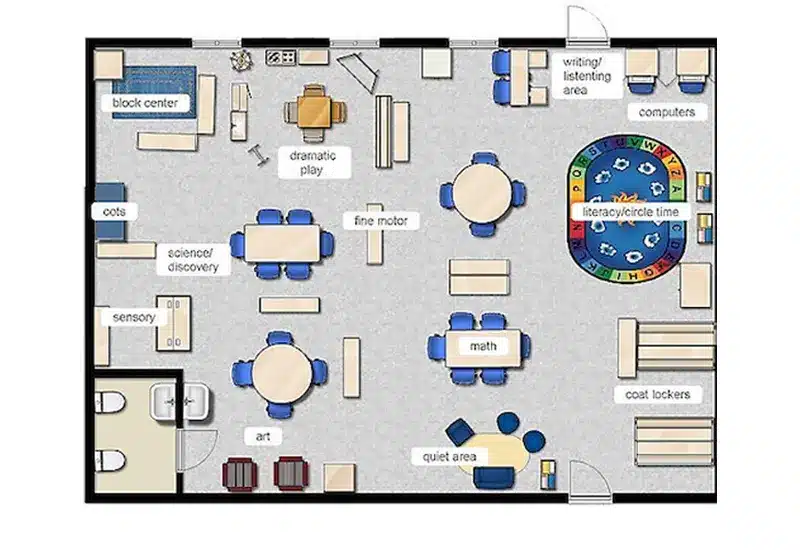
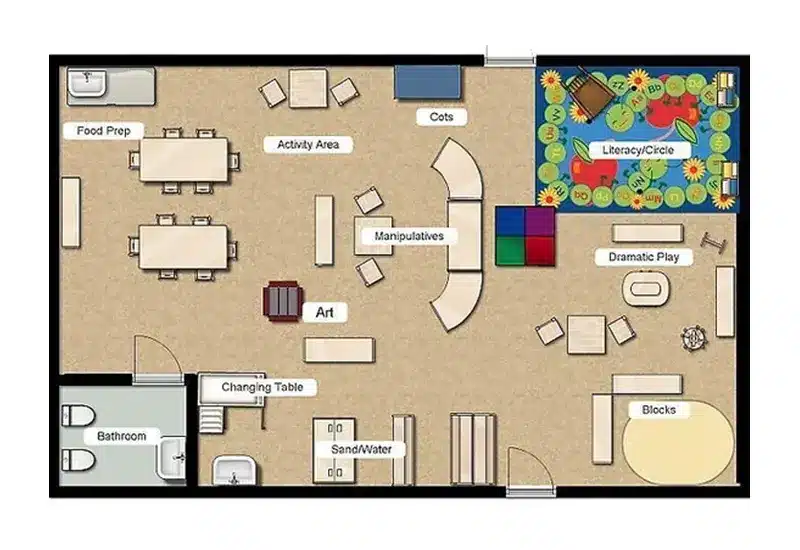
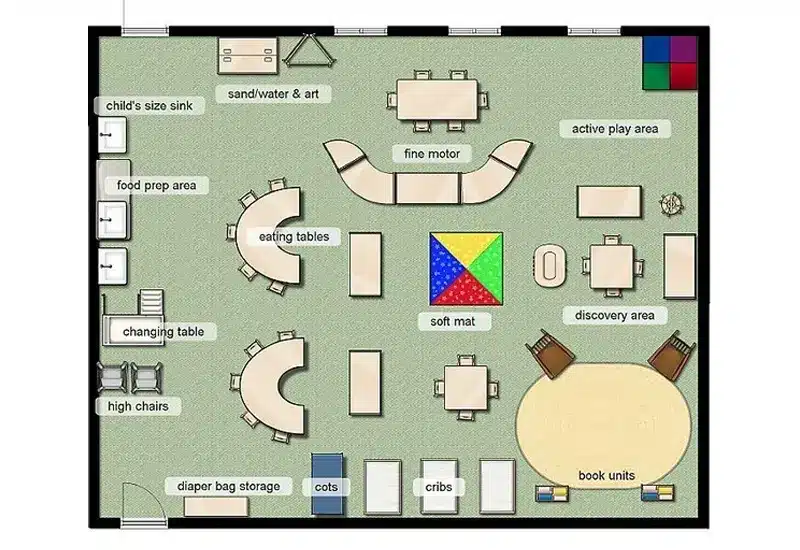
Design classrooms that are spacious and well-organized. Create distinct areas for reading, art, and group play activities. Ensure enough space for children to move freely and engage in various activities.
Use child-friendly furniture with rounded edges, secure heavy furniture to walls, and ensure electrical outlets are covered. Design classrooms to be accessible for all children, including those with disabilities.
Provide a variety of educational materials and resources to support learning. This includes books, puzzles, art supplies, and educational toys. Ensure materials are age-appropriate and promote cognitive, social, and emotional development.
Create a warm, inviting atmosphere with bright colors, natural light, and comfortable furniture. Display children’s artwork to make them feel valued and to create a sense of belonging. Comfortable and aesthetically pleasing classrooms enhance the learning experience.
9. Childcare Outdoor Playground Design


Provide a variety of playground equipment to cater to different ages and interests. This can include swings, slides, climbing structures, and sandboxes. Equipment should promote physical activity, social interaction, and imaginative play. Design the playground to be inclusive and accessible for all children, including those with disabilities.
Incorporate natural elements like trees, plants, and gardens. These elements provide shade, create a more pleasant environment, and offer opportunities for children to learn about nature and gardening.
Ensure the playground meets all safety standards. Use soft ground materials like rubber mulch or sand to prevent injuries from falls. Regularly inspect playground equipment for wear and tear and conduct safety drills with the children.
10. Childcare Furniture and Equipment
Classroom furniture should be chosen according to the size of your classroom, the age of the children, classroom themes, and the educational objectives.
- Age-Appropriate Furniture
Select furniture that is appropriate for the age groups you serve. This includes child-sized tables and chairs, infant cribs, and cozy reading nooks for older children. Age-appropriate furniture ensures safety and comfort. - Multi-Functional Equipment
Invest in multi-functional equipment that can be used for various activities. For example, tables can be adjusted for heights, or storage units can double as play areas. Multi-functional equipment maximizes space and enhances learning experiences. - Durable and Safe Materials
Choose furniture and equipment made from durable and safe materials. Look for items that are easy to clean and maintain. Safety certifications and non-toxic materials are essential to ensure the well-being of the children. - Storage Solutions
Adequate storage is crucial for keeping the classroom organized and clutter-free. Use storage bins, shelves, and cabinets to store toys, supplies, and educational materials. Clearly labeled storage helps children learn organization skills and fosters independence.


11. Preparing Your Childcare Centre
Once you have secured a location and prepared the furniture and equipment, it’s time to prepare your childcare center.
Start by sanitizing your classroom furniture and equipment to ensure safety and sanitation. Take the necessary steps to make your classroom childproof according to the age of the children you care for. Set up play equipment and toy materials. Storage furniture can be used for organization.
12. Developing Policies and Procedures
Clear and comprehensive policies and procedures set expectations for employees, parents and children.
Enrollment Policies
Develop clear guidelines for enrollment. This includes admission criteria, required documentation, and procedures for registration. Transparent policies help manage expectations and ensure a smooth enrollment process.
Health and Safety Procedures
Establish protocols for health and safety, including hygiene practices, illness policies, and emergency response plans. These procedures should be communicated to both staff and parents to ensure everyone understands their roles and responsibilities.
Behavior Management
Create a behavior management policy that outlines acceptable behavior and the consequences of misbehavior. Positive reinforcement strategies should be emphasized to promote a supportive and nurturing environment.
Communication with Parents
Develop policies for regular communication with parents. This can include daily reports, parent-teacher conferences, and newsletters. Open and consistent communication builds trust and keeps parents informed about their child’s progress and any important updates.
13. Hire Staff as Needed
Your staff is the backbone of your childcare centre. Ensure your staff has the necessary qualifications and experience. This includes early childhood education degrees, CPR and first aid certifications, and relevant work experience.
Provide comprehensive training and orientation for new hires. This should cover your centre’s policies, procedures, educational philosophy, and safety protocols. Continuous training opportunities should be offered to support professional growth.
Foster a positive and supportive work environment. Encourage teamwork, provide constructive feedback, and recognize the contributions of your staff. A motivated and happy team is likelier to provide excellent care and education to the children.
14. Marketing Your Childcare Centre
Before your childcare centre can open for business, you must market yourself to attract potential clients.
Develop a comprehensive marketing plan that outlines your goals, target audience and strategies. Identify your center’s unique selling points, such as specialized programs, highly qualified staff or state-of-the-art facilities.
There are many marketing methods:
- Create flyers.
- Participate in community events and build partnerships with local businesses and organizations.
- Hosting open houses, attending community fairs, and partnering with local schools can help increase awareness.
- Create a professional website with detailed information about your center. (You can get a professional website design company to do this for you, but this may cost extra so that you can attract traffic from Google).
- Utilize a social media campaign. Google, Facebook or Instagram.
Advantages of Starting a Childcare Centre
- Growing Need: With increasing numbers of working parents, the demand for reliable childcare services is consistently high.
- Economic Stability: The childcare industry tends to remain stable even during economic downturns, as parents prioritize their children’s care and education.
- Entrepreneurial Opportunities: Running a childcare center allows you to be your boss, create a business from the ground up, and achieve financial independence.
- Skill Development: Managing a childcare center helps develop valuable leadership, business management, and early childhood education skills.
- Innovative Programs: Opportunity to introduce unique programs and activities that cater to children’s diverse needs and interests.
- Building Relationships: Establishing a childcare center fosters connections with families, local businesses, and community organizations.
- Profit Potential: With proper planning and management, a childcare center can be a profitable venture.
- Tax Benefits: Childcare centers often qualify for various tax deductions and incentives, which can reduce operating costs.
- Family Involvement: If you have children of your own, a childcare center allows you to be actively involved in their daily activities and development.
- Flexible Schedule: Owning a childcare center can offer more control over your work schedule than traditional employment.
Starting a childcare center is a meaningful and rewarding endeavor that contributes to the community and offers personal and financial benefits. With careful planning and a commitment to quality care, it can be a fulfilling and successful business venture.

